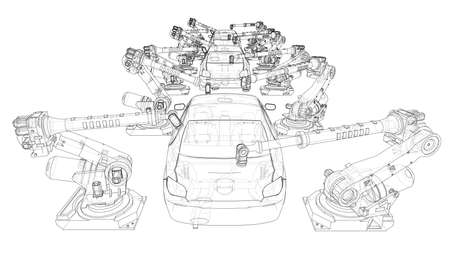1. Introduction to Dyno Tuning
Dyno tuning is a process used to maximize a vehicle’s performance by adjusting its engine parameters. This is done using a dynamometer, commonly known as a dyno, which measures horsepower, torque, and other critical performance metrics. By analyzing this data, mechanics and tuners can fine-tune a car’s engine to improve power, efficiency, and overall drivability.
What Is Dyno Tuning?
Dyno tuning involves placing a vehicle on a dynamometer, which simulates real-world driving conditions in a controlled environment. The data collected allows professionals to adjust fuel delivery, ignition timing, and air-to-fuel ratios, optimizing the car’s performance based on its unique setup.
Purpose of Dyno Tuning
The primary goal of dyno tuning is to maximize an engine’s output while maintaining reliability. Whether you are modifying an engine for more power or simply fine-tuning a stock setup for better fuel efficiency, dyno tuning ensures that your vehicle runs at peak performance.
Key Benefits of Dyno Tuning
| Benefit | Description |
|---|---|
| Increased Horsepower | Fine-tuning the engine’s air-fuel mixture and ignition timing maximizes power output. |
| Better Torque Delivery | Adjustments improve torque characteristics, enhancing acceleration and drivability. |
| Optimized Fuel Efficiency | Precise tuning reduces unnecessary fuel consumption, saving money over time. |
| Improved Engine Longevity | Tuning ensures the engine runs within safe operational limits, reducing wear and tear. |
How Dyno Tuning Enhances Performance
Every engine operates under a set of parameters controlled by the vehicle’s ECU (Engine Control Unit). With dyno tuning, experts can adjust these parameters to achieve the best possible performance for a specific engine setup. Instead of using generic factory settings, custom tuning allows a vehicle to perform at its best based on modifications and driving preferences.
Common Adjustments in Dyno Tuning
- Air/Fuel Ratio Optimization: Balancing the correct mix of air and fuel for combustion.
- Ignition Timing Adjustments: Fine-tuning spark timing to maximize power and efficiency.
- Throttle Response Tuning: Improving how the engine reacts to driver inputs.
- Rev Limiter Adjustments: Modifying RPM limits to accommodate performance upgrades.
Who Should Consider Dyno Tuning?
Dyno tuning is beneficial for a wide range of drivers, from car enthusiasts looking for better performance to racers seeking an edge on the track. Even daily drivers can experience improved fuel economy and smoother acceleration after a dyno session.
2. How a Dynamometer Works
A dynamometer, or “dyno,” is a crucial tool for measuring a vehicles engine performance. It provides precise data on horsepower, torque, and other key performance metrics. But how does it actually work? Lets break down the mechanics behind a dyno.
Types of Dynamometers
There are two main types of dynamometers used in automotive tuning:
| Type | Description |
|---|---|
| Chassis Dyno | Measures power from the wheels by having the car drive onto rollers. |
| Engine Dyno | Measures power directly from the engine, typically outside the vehicle. |
How a Dyno Measures Horsepower and Torque
To determine a vehicle’s power output, a dyno calculates two primary metrics: horsepower and torque.
Torque Measurement
- The vehicle’s wheels (on a chassis dyno) or engine (on an engine dyno) turn a drum or load device.
- The dyno measures the force exerted on this drum, calculating torque in pound-feet (lb-ft).
Horsepower Calculation
- Horsepower is derived from torque and RPM using the formula:
Horsepower (HP) = (Torque × RPM) ÷ 5252
- This formula shows that horsepower is directly influenced by torque and engine speed.
Other Key Performance Metrics
In addition to horsepower and torque, a dyno can measure various factors that impact performance:
- Air-Fuel Ratio (AFR): Ensures the engine is getting the right fuel mixture for optimal performance.
- Throttle Response: Helps assess how quickly the engine reacts to throttle inputs.
- Drivetrain Losses: Calculates how much power is lost through the drivetrain before reaching the wheels.
Why Dyno Testing Matters
By accurately measuring these metrics, dyno tuning allows for fine adjustments to fuel maps, ignition timing, and other parameters. This results in optimized performance, improved efficiency, and a smoother driving experience.

3. Factors Affecting Performance Tuning
When it comes to dyno tuning, several key factors determine your engine’s performance. Adjusting the right variables can maximize horsepower, torque, and overall efficiency. Here, well break down three critical elements of dyno tuning: air-fuel ratio, ignition timing, and RPM optimization.
Air-Fuel Ratio (AFR): Balancing Power and Efficiency
The air-fuel ratio (AFR) refers to the mixture of air and fuel entering the combustion chamber. A well-balanced AFR ensures optimal power output and fuel efficiency. Running too rich (more fuel than necessary) leads to excess fuel consumption and carbon buildup, while a lean mixture (too much air) increases combustion temperatures and can cause engine knock.
| AFR Range | Effects |
|---|---|
| Rich (Below 12:1) | More fuel, cooler temps, lower efficiency, but higher stability |
| Stoichiometric (14.7:1 for gasoline) | Ideal for emissions and efficiency, but not maximum power |
| Lean (Above 16:1) | Increased combustion temps, better fuel economy, but risk of knock |
Ignition Timing: Getting the Spark Just Right
Ignition timing determines when the spark plug fires within the combustion cycle. Proper timing affects how efficiently fuel burns, impacting both power and reliability. Advancing the timing (firing earlier) generally improves power, but too much advance can cause knock and engine damage. Retarding the timing (firing later) reduces power and efficiency but can prevent knock in high-load conditions.
How Ignition Timing Impacts Performance
- Advanced Timing – More power, but risk of knock if too aggressive.
- Retarded Timing – Reduced power, but safer under high boost or load.
- Dynamic Timing Adjustments – Tuning software can make real-time adjustments based on conditions.
RPM Optimization: Finding the Power Band
Your engine’s RPM range affects where it makes peak horsepower and torque. A dyno tune helps optimize fuel and ignition settings across this range, ensuring smooth power delivery and efficiency. Tuning for the correct RPM band allows improved acceleration, drivability, and engine longevity.
Key Considerations for RPM Optimization
- Low RPM Tuning – Focus on smooth throttle response and fuel efficiency.
- Mid RPM Tuning – Balancing power and efficiency for daily driving.
- High RPM Tuning – Maximizing horsepower for peak performance.
Final Thoughts on Performance Variables
Understanding air-fuel ratios, ignition timing, and RPM optimization is crucial when dyno tuning a vehicle. These parameters, when adjusted correctly, help unleash the full potential of an engine without sacrificing reliability. In the next section, well dive deeper into how real-world driving conditions influence dyno tuning adjustments.
4. Maximizing Horsepower and Torque
When it comes to dyno tuning, the ultimate goal is to maximize both horsepower and torque while ensuring the engine runs efficiently. Achieving this involves making precise adjustments to key engine parameters like air-fuel ratio, ignition timing, and boost levels. By fine-tuning these elements, you can unlock the full potential of your engine while maintaining reliability.
Air-Fuel Ratio Optimization
The air-fuel ratio (AFR) plays a crucial role in engine performance. A well-tuned AFR ensures that the engine receives the right mixture of air and fuel for efficient combustion. Running too rich (too much fuel) can cause unnecessary fuel consumption, while running too lean (too little fuel) can lead to excessive heat, pre-detonation, and engine damage.
| Condition | Air-Fuel Ratio | Effects |
|---|---|---|
| Lean | Above 14.7:1 | Increased fuel efficiency, higher combustion temperatures, risk of engine knock |
| Optimal | 12.5:1 – 13.2:1 (for performance) | Balanced power and efficiency |
| Rich | Below 12.0:1 | Lower combustion temperature, increased fuel consumption, potential power loss |
Ignition Timing Adjustments
Ignition timing determines when the spark plug fires during the combustion cycle. Advancing the timing can lead to more power, but too much advance can cause knocking. Retarding the timing prevents knock but may reduce power output. Dyno tuning helps find the optimal ignition timing for maximum efficiency and performance.
Signs of Improper Ignition Timing
- Knocking or pinging: Timing is too advanced
- Sluggish acceleration: Timing is too retarded
- Poor fuel economy: Inefficient combustion due to incorrect timing
Boost Level Fine-Tuning
For turbocharged and supercharged engines, adjusting boost levels is another critical factor in maximizing power. Increasing boost pressure forces more air into the engine, allowing for a higher fuel burn and greater output. However, excessive boost can strain internal components and lead to detonation. Dyno tuning ensures that boost is optimized for safe, reliable power gains.
Factors Affecting Boost Control
- Turbo size and efficiency
- Intercooler effectiveness
- Fuel octane rating
- Engine internals strength
By fine-tuning these key aspects, dyno tuning helps extract maximum power and efficiency from an engine, ensuring an optimal balance between performance and reliability.
5. Benefits of Dyno Tuning
Dyno tuning isnt just about cranking out maximum horsepower—its about optimizing your vehicle for better overall performance. From improving fuel efficiency to ensuring smoother power delivery and extending engine longevity, dyno tuning offers several advantages that every car enthusiast should consider.
Improved Fuel Efficiency
One of the most practical benefits of dyno tuning is better fuel efficiency. When your engine is properly tuned, it doesn’t have to work as hard, leading to optimized air-fuel ratios and better combustion. This means you’ll get more miles per gallon (MPG), saving you money at the pump while reducing unnecessary fuel waste.
Smoother Power Delivery
A poorly tuned engine can cause jerky acceleration and inconsistent power output. Dyno tuning helps refine the engine’s performance, ensuring the power is delivered smoothly across the RPM range. This not only enhances the driving experience but also prevents unnecessary stress on the drivetrain.
Extended Engine Longevity
When an engine runs efficiently, it experiences less strain and wear. Without a proper tune, excessive fuel consumption, improper timing, or inefficient air-to-fuel ratios can lead to premature wear. Dyno tuning optimizes these variables to prevent unnecessary engine stress, ultimately improving reliability and longevity.
Comparison of Key Dyno Tuning Benefits
| Benefit | How It Helps |
|---|---|
| Better Fuel Efficiency | Optimizes air-fuel ratio, reducing wasted fuel and improving MPG. |
| Smoother Power Delivery | Eliminates power surges and inconsistencies, leading to better acceleration. |
| Extended Engine Life | Reduces wear and tear, preventing premature engine damage. |
Is Dyno Tuning Right for You?
Whether you’re looking for better performance, efficiency, or longevity, dyno tuning is a great way to optimize your car’s engine. It’s a worthwhile investment for daily drivers and performance enthusiasts alike. If youve never had your vehicle professionally tuned, a dyno session could reveal how much potential your engine really has.


